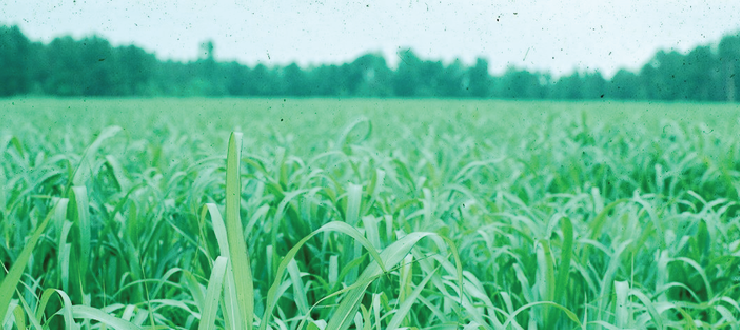
PRUSSIC ACID POISONING
Some highly useful forage crops can be toxic in certain situations. The photograph above shows a field of sorghum-sudan hybrid, a fast-growing summer annual grass, which can provide good yields of nutritious forage. However, it is one of the forage crops that can cause prussic acid (also called hydrocyanic or HCN) poisoning.
Other species in the Sorghum genus that can also cause this disorder are sorghum, sudangrass, and johnsongrass. Some sorghum and sudangrass varieties have less potential for causing poisoning than others. In addition, another plant that is not a forage crop, but that is common and can cause this syndrome is wild cherry.
Prussic acid poisoning may occur when livestock consume the plants mentioned. This disorder is most likely to occur immediately after a killing frost. Shoots of plants in the Sorghum genus that appear after a frost are likely to contain extremely high levels of prussic acid, and thus be particularly dangerous. For this reason, in autumn it is particularly important for forage/livestock producers who grow these forage crops to consider whether there may be a possibility of prussic acid poisoning to their animals.
Prussic acid causes death by interfering with the oxygen-transferring ability of the red blood cells of an animal, essentially causing cellular level suffocation. Excessive salivation, rapid breathing, and muscle spasms, and may occur within 10 to 15 minutes after an animal consumes forage containing high levels of prussic acid. Animals may stagger, collapse, and eventually die.
In addition to the likelihood of prussic acid building up to dangerous levels immediately after a frost, tender young growth occurring immediately after a long drought can be potentially toxic. Young, tender, fast-growing plants are more likely to be toxic than older, more mature plants. Also, there is more prussic acid in upper leaves than in lower leaves. Herbicides may also temporarily increase prussic acid levels.
Prussic acid is not the same as nitrate poisoning, although both can occur with plants in the Sorghum genus. Toxic levels of nitrates result from heavy nitrogen fertilization followed by severe drought stress. Unlike nitrates, prussic acid deteriorates with time. If forage having high levels of prussic acid is ensiled, it will usually be safe to feed within three weeks after silo fill.
Hay that has dried enough to be safely baled (no more than18 to 20 percent moisture) will not contain toxic levels of prussic acid. Standing plants killed by frost are normally safe after about one week. However, in some instances, only plants in certain portions of a field are killed initially, and subsequent frosts create danger spots in other areas.
Grazing of plants that have the potential for developing toxic levels of prussic acid should be avoided until at least a week after the end of a severe drought or when frost is possible. Once frost occurs, grazing or feeding greenchop should be avoided for at least a week after the last green material has been frosted. Hungry cattle should not be given access to potentially toxic pastures or those containing wild cherry trees. Livestock should never be given access to limbs trimmed from wild cherry trees.
Foraging Ahead is a column presented by Ragan & Massey and written by Dr. Don Ball, Professor Emeritus at Auburn University. Dr. Ball is one of the authors of the popular book “Southern Forages,” which can be found via a computer search that uses the words, “Southern Forages, The Fertilizer Institute.”